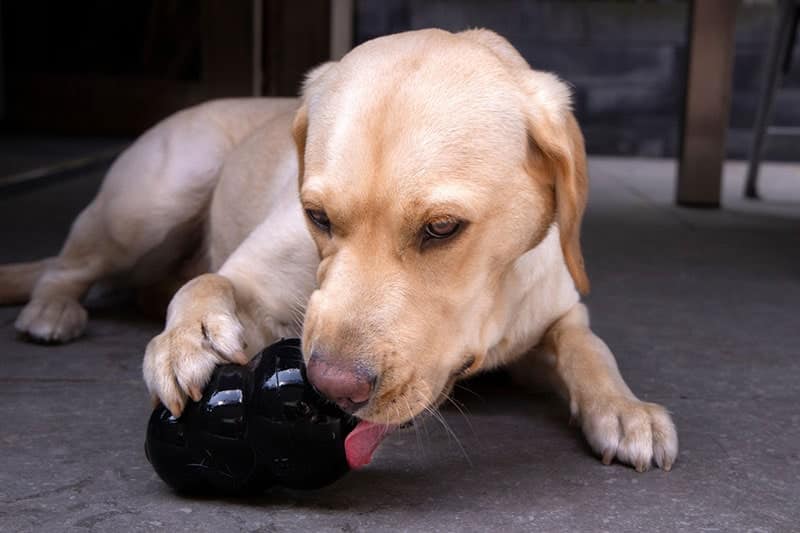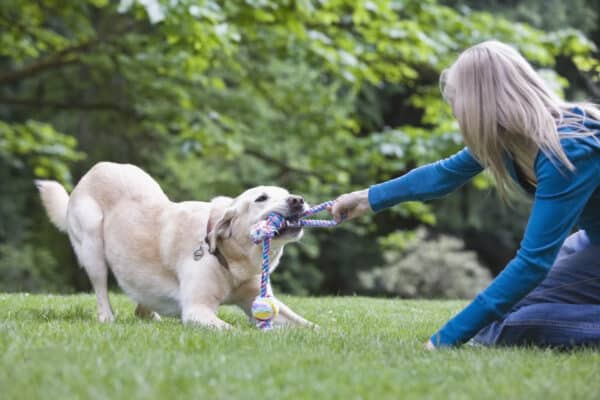Is any dog toy really indestructible? The short answer: No. Durable dog toys might stand up to rough play. But they are not indestructible, says Holly Lewis, founder of Cold Nose Canine. A durable toy is going to be different for every dog. Choosing a virtually indestructible dog toy is an example of natural selection. No matter how pricey or quirky your pup’s new plaything is, he might crush or ignore it unless it fits his play style.

Choosing Durable Dog Toys Using Your Dog’s Play Style
Indestructible dog toys are made from a wide range of materials, from bullet-proof Kevlar to recycled plastic canvas. Their durability depends on your dog’s play style. Here are seven canine play styles.
- Tuggers: Have a tug-of-war champ? Look for rope toys interwoven or reinforced with knots, rubber or nylon, like the Rompidogz Rugged Tug n Toss Rope. Have a large dog breed? Try an extra long rope toy so your aggressive chewer won’t always bite it in the same spot. And, add the human touch with toys that are handheld tug toys like the Tether Tug.
- Chewers: Rubber dog toys like the West Paw Hurley can withstand excessive chomping. Nylon can chip or break your dog’s teeth, Holly says. The general rule of thumb: It is safe if you can indent a nylon dog toy with your thumbnail.
- Fetchers: Tennis-ball fuzz can wear down your dog’s teeth like sandpaper. Stick to recycled plastic, all-natural rubber and silicone fetch toys. Invest in a dog toy launcher like the Chuckit! Sport Launcher Dog Toy.
- Hunters: Hunting breeds like Airedale Terriers might shake or rip their squeaky dog toys apart. If the squeaker is covered with nylon fabric, fire hose or latex, it still can pop. Rubber is harder for your power chewer to penetrate for a durable squeaky dog toy. An example is the Hyper Pet Dura-Squeaks Dog Chew Toy.
- Workers: Give canine workaholics a food-dispensing toy like the West Paw Rumbl. Fill it with kibble and watch it wobble, keeping your dog engaged. Or, you can fill a toy like the ZoomieRex IncrediBall with yogurt or wet food, freeze it and watch your dog play for hours. Hide-n-seek toys make great choices for dogs who like to work for their toys — and then chew on and snuggle with them. Examples are Bulltug Companies’ Trash N Seek and Zippy Paws Zippy Burrow
- Cuddlers: Human stuffed animals might not immediately undergo an instant fluffectomy, but their plastic eyes and satin neck ribbons are choking hazards. Anti-bacterial poly-fill can also turn into a toxic gel, and stick to your dog’s intestines. Buy plush dog toys made of ballistic nylon, heavy-duty canvas or Kevlar. Holly says, goDog toys have a double liner and reinforced seams. Also, Outward Hound has an Xtreme Seamz Zebra Squeaky Plush Toy, and even when the squeaky goes, the toys last awhile for most dogs.

Rotate your dog’s durable toys
According to a 2008 study in Animal Cognition, 76% of dogs will pick unfamiliar objects over old toys. But rotating 10 used dog toys every 7 to 14 days can make them feel new again. There are some that you might choose to keep out because there are perennial favorites, Holly says. Keep out a mix of soft and hard dog toys. Add new scents by rolling them in grass or aniseed (aka “catnip for dogs”).
Takeaway tips for durable dog toys
- Go for the lifetime guarantee. Dog toy brands like RuffDawg and Goughnuts have a lifetime toy replacement guarantee, so you will get more bang for your buck for durable dog toys for aggressive chewers.
- Stick with a dog toy subscription box built for heavy chewers. Stop shuffling through endless customer reviews to find durable dog toys for moderate and aggressive chewers that can survive your pooch’s Jaws-of-Life. Dog toy subscription companies like BarkBox can send indestructible dog toys straight to your door. Here’s a full list of these companies.
- Never use dog toys as a replacement for human interaction. If you are not around to offer encouragement, indestructible dog toys will not capture your pup’s interest for very long.
Featured Image Credit: Jetta Productions/Walter Hodges / Getty Images










